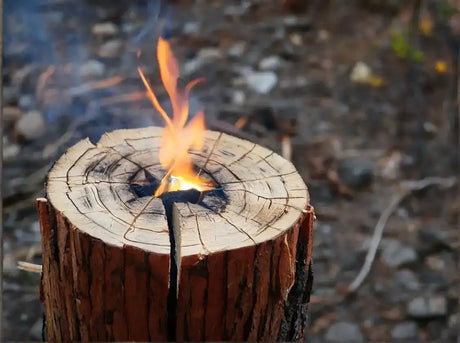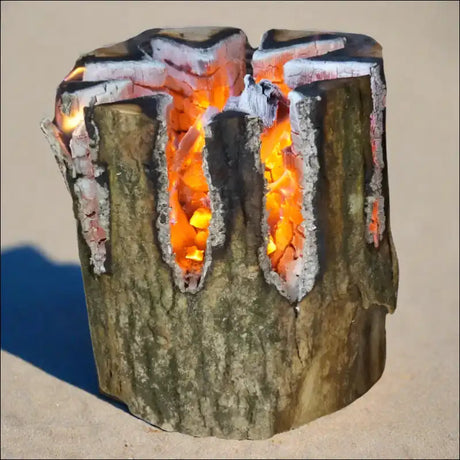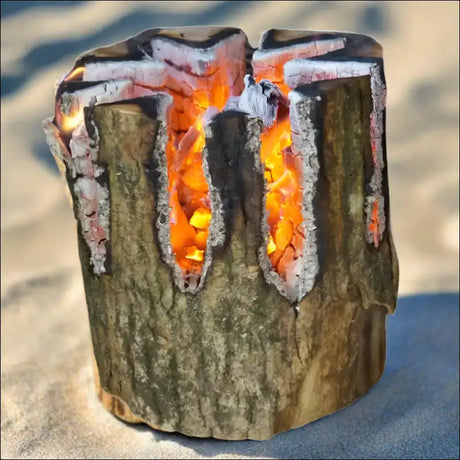For firewood enthusiasts, obtaining well-seasoned logs is absolutely crucial for an enjoyable and efficient wood burning experience. But what exactly does "seasoned" firewood mean and why does it matter so much?
In this comprehensive guide, we'll look at:
- What is seasoned firewood and how is it created
- The benefits of burning seasoned firewood
- How to tell if firewood is properly seasoned
- Tips for seasoning firewood yourself
- Common mistakes when seasoning firewood
- Reasons why seasoning firewood matters for your health and safety

What Does "Seasoned" Firewood Mean?
Seasoned firewood refers to logs that have been dried out and cured over time to reduce their moisture content. This drying process allows for cleaner, hotter burning wood that produces less smoke and dangerous creosote buildup.
Freshly cut "green" wood can have a moisture content of over 60%, whereas well-seasoned wood should have a moisture content of 20% or less. The ideal moisture content for firewood is 15-20%.
So how does wood transition from wet and green to nicely seasoned? Time and proper storage is key.
Air Drying
Leaving freshly cut logs out in the open air for 6 months to 2 years allows moisture to evaporate from the wood. Sun and wind exposure speeds up the drying process. Hardwoods like oak, ash, and beech require the longest seasoning time, up to 2 years, while softer woods like pine can season in 6 months.
Kiln Drying
Kiln drying uses a controlled environment to rapidly remove moisture from wood. Logs are placed in a specialized kiln that blows hot dry air over the wood, decreasing drying time to just weeks or months. The intense heat can also sterilize logs and kill any pests or fungal spores.
Kiln drying yields very consistent seasoned firewood, but at a higher cost. Air dried firewood is slower and less predictable, but cheaper.
Why Burn Seasoned Firewood? 7 Key Benefits
From efficiency to safety, properly seasoned firewood provides some major advantages over burning wet green wood. Here are 7 benefits of seasoning your firewood:
1. Produces More Heat Output
Seasoned wood with 15-20% moisture burns significantly hotter than wet wood. More heat energy goes into warming your home instead of evaporating water. Wet wood with just 25% moisture can reduce heat output by 15-25%!
2. Lights and Burns Faster
Less moisture means the wood ignites faster and the fire progresses quicker. No more waiting around for wet logs to catch. Quick, hot fires are great for short duration cooking with lumpwood charcoal.
3. Less Smoke and Creosote Buildup
Wet wood causes more smoke and deposits creosote, a gunky black tar, in chimneys and stoves. Creosote is highly flammable and the leading cause of chimney fires. Well seasoned wood burns cleaner for less smoke and creosote.
4. Fewer Emissions and Pollution
The increased smoke from burning wet wood produces more harmful particulate emissions linked to heart and lung disease. Seasoned wood has 50% lower emissions for your health and air quality.
5. Higher Burning Efficiency
Seasoned wood's hotter fire and lower moisture allows for up to 33% greater burning efficiency. Less unburnt hydrocarbons and more complete combustion.
6. Use Less Wood Overall
The improved heat output, speed, and efficiency of seasoned wood means you'll use 15-40% less wood to get the same heating effect. Save money on your fuel costs.
7. Prevents Wood Decay and Pests
Wet wood that doesn't dry fully can start decaying from fungal growth and cause damage in logs. Proper seasoning dries wood thoroughly to stop fungal spread and prevents pests like termites that target damp wood.
With all these advantages, it's easy to see why taking the time to properly season wood results in a vastly superior burning experience.
How to Tell if Firewood is Well Seasoned
Looking to buy or use some seasoned firewood but not sure how to evaluate its dryness? Here are some tips for assessing seasoning:
-
Check the ends of logs - Well seasoned wood has deep cracks radiating from the center, while wet wood has a mostly solid cross section.
-
Bang logs together - Seasoned logs sound hollow and crisp, whereas wet wood thuds dully.
-
Weigh the wood - Dry wood is considerably lighter than fresh cut green wood. Hardwood should weigh under 2.2 pounds per cubic foot (35 kg/m3) when 15-20% moisture.
-
Use a moisture meter - For the most accurate measurement, use a moisture meter to test the internal moisture content. Look for readings of 20% or less.
-
Burn test - Light a small fire and observe burn characteristics. Wet wood hisses and sizzles, seasoned logs ignite quickly with a robust flame.
With a little inspection, you can easily discern proper seasoning and pick ideal dry firewood.

Best Practices For Seasoning Firewood Yourself
Want to save money by seasoning and drying logs yourself? Here are some top tips for optimal results:
-
Start early - Seasoning takes 6-24 months. Start the process 1-2 years before burning to ensure fully dried wood.
-
Cut wood to length - Shorter logs like 14-16 inch lengths dry faster than huge 4 foot logs. More exposed surface area.
-
Split logs - Splitting wood exposes more internal surface for moisture to evaporate. Don't split too early or logs can crack and split on their own.
-
Stack off the ground - Stack cut and split wood on pallets or rails to allow air circulation underneath. This prevents dampness.
-
Allow sun and wind exposure - Position wood stacks in direct sunlight and wind flow for maximum drying power. Turn and rotate stacks occasionally.
-
Cover top only - Cover just the top of the stack with plywood or plastic to keep rain and snow out, while still allowing airflow.
-
Avoid tarps on sides - Don't wrap up the whole stack, it restricts vital air movement and ventilation that removes moisture.
With the right prep and conditions, you can achieve quality seasoned firewood for a fraction of the cost.
Common Mistakes That Produce Poorly Seasoned Wood
Many inexperienced wood burners unknowingly make mistakes that result in poorly seasoned or still-wet firewood. Avoid these pitfalls:
-
Not allowing enough time - Remember most wood needs 6-24 months to fully season. Don't cut, split, and burn wood in just a few months.
-
Stacking logs on the ground - Direct ground contact keeps logs damp and prevents drying. Always stack on rails or pallets.
-
Failing to split large logs - Big intact logs can trap moisture inside. Split to speed seasoning.
-
Wrapping stack completely in tarps - Restricts airflow and prevents moisture escape. Only cover the top.
-
Storing wood in enclosed spaces - Wood needs sun and wind exposure. Don't season in garages or sheds.
-
Stacked too close together - Too tight of a stack prevents ventilation. Keep rows spaced apart.
-
Not rotating or loosening stack - Compacted stacks can become matted over time. Loosen and rotate periodically.
With good stacking technique and proper drying conditions, you can avoid these common pitfalls on your way to perfectly seasoned firewood.

Why Seasoned Firewood Matters For Safety and Performance
Beyond just better burning characteristics, using well seasoned firewood also has critical implications for safety and equipment performance. Here are some key reasons it matters:
-
Prevents chimney fires - Wet wood's creosote buildup drastically increases dangerous chimney fire risk. Seasoned wood burns cleaner.
-
Less risk of uncontrolled fires - Dry seasoned wood ignites and burns in a steady, controlled manner unlike fresh wet wood that can flare up erratically.
-
Protects stoves/fireplaces - Wet wood releases corrosive organic acids that can damage stoves. Seasoned wood creates less acidity and corrosion.
-
Fewer air quality issues - Wet wood smoke worsens indoor and outdoor air pollution. Seasoned wood cuts emissions by 50%
-
Better for health - Reducing firewood smoke through seasoning decreases health risks like asthma and lung irritation.
So seasoning wood is not only about convenience or cost savings, it's also vitally important for safety and reducing risks when wood burning.
In Conclusion: Start Seasoning Wood Today
Hopefully this guide has convinced you of the substantial benefits of burning properly seasoned firewood and equipped you with the knowledge to start seasoning wood for your own use.
The seasoning process takes patience and planning, but the payoff in firewood performance, safety and cost-savings make it well worth the effort. Take the time to season wood correctly, and you'll get more heat, less smoke, and bigger savings from every firewood load.
Check out our quality selection of kiln dried firewood and lumpwood charcoal for your burning needs today. And remember to start seasoning some logs yourself for next season. Your future firewood burning self will thank you!








